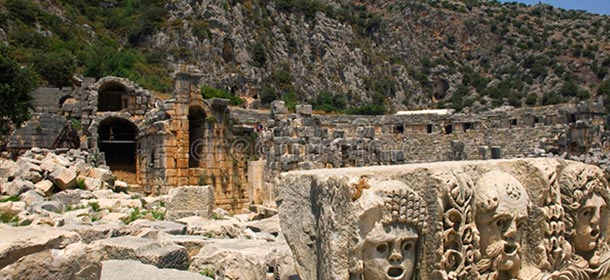The most important archaeological sites and natural wonders of Turkey
Day 01 : Arrive Istanbul
Welcome to Istanbul, one of the most beautiful cities of the world lies on 2 continents. On your arrival, representative will meet you at the airport after the customs and baggage claim with a sign YOUR NAME on it, then transfer to your hotel. Dinner and overnight in Istanbul (D)
Day 02: Istanbul
Morning visit the Turkish and Islamic Art Museum , this museum is housed in the magnificent palace built in the 15th century by Ibrahim Pasha Grand Vizier and son-in law to Suleyman the Magnificent . It contains a superb collection of more than 40,000 artefacts dating from the 7th century BC on ward to present, with exhibits of fine art, crafts(including exquisite old Turkish carpets and Turkish domestic life in its evolution from nomad’s tent to modern home. Next visit the Roman Hippodrome was the centre of Byzantium’s life for 100 years and of Ottoman life for another 400 ears and has been the scene of countless political dramas, demonstration, riots and state ceremonies which is next to Turkish and Islamic Art Museum. Proceed to the opulent Topkapi Palace’s compound with its courtyards, harem, and pavilions, offers a fascinating glimpse into lives of Ottoman sultans. During its heyday, royal wives, children concubines, eunuchs, and servants were among the 4000 people living within Topkapi Palace, which also served as administration centre of the Ottoman empire for 400 years. It is now a museum housing a world renowned collection of jewellery, artefacts, Sultans’ personal belongings and porcelain. Then visit the 6th century St. Sophia‘s (Hagia Sophia) built by the emperor Justinian, to be the grandest church of Christianity, stands out among Istanbul’s many important monuments , with its innovative architectural form ,rich history, religious importance and extra ordinary beauty. It was converted to a mosque by Mehmet the Conqueror in 1453 and into a museum by Ataturk in 1935. (B,D)
Day 03 : Istanbul - Ankara
Morning visit to the famous Covered Bazaar, one of the oldest , biggest and most exciting shopping malls in the world, the Grand Bazaar was setup in the 15th century by Ottoman Turks as a hub of commerce and centre of trade. This labyrinth of streets covered by painted vaults is lined with 4000 thousands of booth-like shops. Afternoon flight to Ankara and visit the Museum of Anatolian Civilizations ,this superb museum in Ankara is the perfect introduction to the complex weave of Turkey’s ancient history, housing extraordinary artefacts excavated and picked from every significant archaeological site in Anatolia. The museum exhibits from the earlier Anatolian civilizations: Palaeolithic, Neolithic, Chalcolithic, Bronze Age, Assyrian, Hittite, Phrygian, Urartian, Lydian, classical Greek and Roman artefacts and Ankara history . Dinner and overnight in Ankara. (B,D)
Day 04: Ankara - Bogazkale - Yazilikaya - Ankara
Morning departure for the capital city of the Hittite Empire Visit Bogazkale (Hattusas) which is known as the city of temples. See the Kings Gate, the Lions Gate, the tunnel, great citadel, grand temple and the museum. Also see the ancient site of Yazilikaya (inscribed rock-rock written sanctuary)), close to Bogazkale. This is the most famous of the Hittite rock monuments. Here there is also an open air pantheon. Reliefs of Hittite gods and goddesses adorn the walls. These are carved into the native rock and date back to the 13th century BC. Return to Ankara for dinner and overnight (B,D).
Day 05 : Ankara – Gordion – Catalhoyuk – Konya
Drive via Polatli town to Gordion, the capital of the Phrygian Kingdom in the mid-9th century B.C. Visit the site of ancient city of Gordion and Tomb of King Midas. Then drive to Catalhoyuk, the Neolithic Anatolian Hoyuk(Mund) Since 1993 an international team of archaeologists, led by Professor Ian Hodder, has been carrying out new research at Çatalhöyük. Catalhoyuk was a very large Neolithic and Chalcolithic proto-city settlement in Anatolia, which existed from 7500BC to 5700 BC. It was the first place where town life and city plan started. Some animals domesticated. The food is produced by agriculture, with the cultivation of wheat and barley and by breeding cattle. In addition to meat and milk, the cattle provide transport as beast of burden. The population is calculated to number about 5000, living in 1000 houses. Then drive to Konya, ancient Iconium for dinner and overnight. (B,D)
Day 06 : Konya – Side – Perga – Aspendos - Antalya
Drive to Antalya. A full day sightseeing of the Pamphylian cities of Aspendos, Side and Perge and their striking Greco-Roman Archaeological sites along the Turkish Riviera. Stop first at Aspendos, has the best perfectly preserved extant Roman Theatre in Asia Minor with its 15,000 estimated capacity–it is still used to stage the annual Aspendos Opera and Ballet Festival which was built in the second century AD. The city prospered in the second and third centuries AD is still visible. Enormous blocks of marble were transported from as far as the Marmara Island for the construction and ornamentation of its imposing buildings. After lunch break continue to Side, an ancient Turkish harbour that has made a graceful transition into a lovely resort village. Side has been colonized by Aeolians who came down south from Aeolia(North Western –Aegean Coast) in the 7th century BC. According to Strabo, Side was deeply involved with the pirates, allowing them to sell their prisoners( slaves)in city’s market-agora and to repair their ships in the harbour in the second century BC, who made large profits from slave trading. Under the Romans it remained an important slave market.Its present popularity is due not only to its new resort atmosphere, but also to the many archaeological ruins that permeate this ancient settlement. The Theatre is the most prominent structure from Roman period after visiting Theatre, Agora, Temple of Apollo and Archaeological Museum, drive to Perge, was a wealthy and culturally well-developed city in ancient time, was founded after the Trojan War. Perge prospered during the Roman period that many of the city’s finest buildings, whose remains are still visible , were constructed. St Paul and Barnabas visited Perge on their first missionary journey. See its Theatre, Stadium, City Gates, Agora, Bath and Colonnaded Avenue with a water canal in the middle. Dinner and overnight in Antalya i(B,L,D)
Day 07: Antalya - Phaselis – Antalya
Visit the award winning Archaeological Museum of Antalya in the morning. Then drive along the shore of Mediterranean to Phaselis to visit the Roman city of Phaselis .See the theatre, ancient harbours, bath and city gates of Phaselis and then return to Antalya for dinner and overnight. (B,D)
Day 08: Laodicea – Hiearpolis - Pamukkale
Drive to Pamukkale. First visit Laodicea and the newly excavated area, was founded in the third century BC and flourished especially in textile production until an earthquake in the fifth century AD . See the Roman ruins include a gymnasium, baths, two theatres, colonnaded street, fountains and the remands of a stadium. Then visit Hierapolis, in Hellenistic times, the therma springs at Hierapolis made the city a popular spa. Today, the ruins of Hierapolis still draw visitors , who come to swim in its mineral rich hot pools and see the startling white travertine terraces of nearby Pamukkale. See its Theatre, the Necropolis, the City Gates with its Walls and colonnaded Avenue and the Archaeological Museum, meanwhile and enjoy walking on unique white (cotton castle look -like ) lime stone formation. Dinner and overnight at the hotel. Swimming is available at the hot spring pool of your hotel. (B,D)
Day09: Pamukkale - Aphrodisias – Nysa - Kusadasi
Drive to Aphrodisias, the beautiful city , is one of the finest sites of Anatolia, this ancient site was associated with fertility cults rom as early as the Bronze Age, the recently excavated Roman city dedicated to the Goddess of Love, Aphrodite. The site is being excavated by the New York University. The excavations are still going on as in many other ancient sites. The Romans transformed Aphrodisias into a major cultural, science centre. It was renowned in particular for its school of sculpture, and Aphrodisian works adorned every corners of the Roman Empire including Rome itself and ancient city enjoyed its prosperity during Roman period. See the Hadrian Baths, the Theatre, Double Agoras, the Temple of Aphrodite, the Odeon, the Tetra pylon, the Roman Stadium Stadium which is one of the best preserved structures of its kind from the classical era., the Theatre, the Agora and the beautiful Archaeological Museum containing the best Aphrodite Statues in Anatolia. Continue to the ancient city of Nysa, a Seleucid foundation from around 280 BC, present a lovely sights as you approach from main road. During the Roman era it was famous as an academic centre, attracting pupils from throughout Asia Minor. Strabo studied here. See its ruins from Hellenistic and Roman periods including Theatre, Bouleuterion, Agora, Stadium, Gymnasium and Byzantine Church . Proceed to Kusadasi for dinner and overnight. (B,D)
Day 10: Miletus – Didyma – Priene – Kusadasi ( The splendours of Ionia)
Drive to Miletus to visit the Theatre and the other remains of the city. Miletus is probably the oldest of all the Ionian cities , the human habitation going back to at least the 16th century BC. and also by far the most important of the Greek colonies established along the Aegean coast.. Continue to Didyma to see the Temple of Apollo which was the Oracle centre of Asia Minor and one of the most magnificent sights in all of Asia Minor.. Then visit the Greco-Roman city of Priene which is the most superbly situated of all the ancient Ionian cities, standing on a tiered terrace of Mount Samsun(Mycale) well above the Meander valley. Priene is by far the finest extant example of a Hellenistic town planned on the Hippodamian( Hippodamus) model(city plan). Alexander the Great stayed here on his way during his liberation of Anatolia from Persian occupation in 334 BC. See the remains of city including Temple of Athena built in the 4th century BC, the most prominent monument in Priene, the Theatre, the Agora, the Bouleuterion (Council house). Return to Kusadasi for dinner and overnight. (B,D)
Day 11: Ephesus - Izmir (Smyrna)
Leave for Ephesus. Visit the Shrine of the Virgin Mary where she supposedly spent her later days. Proceed to Ephesus, was the capital of the Roman province of Asia Minor with a population of 250,000.It was a major political, commercial and cultural centre, and the romans spared no expense in making this a showcase city or their civilization. It has been very well preserved and is one of the major ancient cites around the Mediterranean and Aegean, and see the spectacular ruins from the Roam period some of which are only recently excavated. See the Odeon, the Bouleterion, the Fountains, the Temples, the Brothel, the Library, the Agoras, the Great theatre, the Roman Baths, well preserved marble Streets , Avenues, the Gymnasiums and terrace House., the Archaeological Museum, St. John’s Basilica and his tomb and the Temple of Artemis (one of the Seven Wonders of the ancient world). Continue to Izmir for dinner and overnight. (B,D)
Day 12: Wed Sardes – Smyrna – Izmir
Drive East to Sardis, the capital of the Lydian Empire where the coin is first invented. See the 3rd century Synagogue, the great Gymnasium, the golden river Pactalos, the Royal Road and the Temple of Artemis. Return to Izmir and visit the Roman Agora and the new Archaeology Museum in fair area. Dinner and overnight in Izmir. (B,D)
Day 13 : Thu Pergamon – Assos /Ayvalik
Drive to Pergamum which is one of the most impressive archaeological sites in all of Turkey, perched atop on a high hill with a panoramic view. Its attractions in Acropolis are a 10,000-seat steepest theatre of ancient world, the magnificently restored temple of Trajan; a library of 200,000 volumes second in size only to that in Alexandria; the base of the Altar of Zeus; the temple of Dionysus, the Royal Palaces, Arsenal and City Walls; down the valley we also visit old Red Basilica and the medical centre of Asclepius with its own theatre, library, underground tunnel and other healing buildings. Proceed to Assos to see the ruins of ancient city and the Temple of Athena overlooking the Aegean Sea. Dinner and overnight in Assos. /Ayvalik (B,D)
Day 14 : Troy - Gallipoli - Istanbul
Drive to Homer’s legendary Troy, famous for its wooden horse. Archaeological digs have proved that there had been nine separate periods of settlement in Troy. Cross the Dardanelles by car-ferry, after visiting the WW I battle fields , drive to Istanbul for dinner and overnight. (B,D)
Day 15:Sat Istanbul
Visit the Archaeological Museum containing the greatest treasures of Greek and Roman antiquities discovered in Turkey Istanbul Archaeological Museums ,this superb containing the greatest treasure of Greek and Roman antiquities discovered in Turkey, museum houses outstanding collection from several regions of Ottoman territory with an extensive collection of classical period, pre -Islamic period, Greek and Roman period and including statuary, sarcophagi, plus a sprawling exhibits documenting Istanbul’s history. Visit the Blue Mosque , everyone’s favourite with its six slender minarets and blue Iznik tiles, and the Underground Cistern. We take an afternoon boat tour which take us along both the European and Asiatic shores of the Bosphorus. Tonight a farewell dinner at an outdoor seafood restaurant. (B,D)
Day 16: Sun Istanbul - End
Transfer to Istanbul airport. Fly back to Denver. End of our services. (B)


